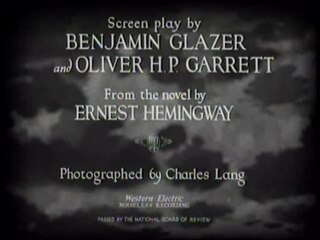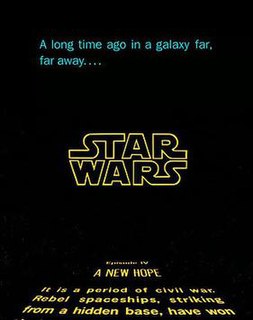
A silent film is a film with no synchronized recorded sound. Though silent films convey narrative and emotion visually, various plot elements or key lines of dialogue may, when necessary, be conveyed by the use of title cards.

A storyboard is a graphic organizer that consists of illustrations or images displayed in sequence for the purpose of pre-visualizing a motion picture, animation, motion graphic or interactive media sequence. The storyboarding process, in the form it is known today, was developed at Walt Disney Productions during the early 1930s, after several years of similar processes being in use at Walt Disney and other animation studios.
A title sequence is the method by which films or television programmes present their title and key production and cast members, utilizing conceptual visuals and sound. It typically includes the text of the opening credits, and helps establish the setting and tone of the program. It may consist of live action, animation, music, still images, and/or graphics. In some films, the title sequence is preceded by a cold open.

In a motion picture, television program or video game, the opening credits or opening titles are shown at the very beginning and list the most important members of the production. They are now usually shown as text superimposed on a blank screen or static pictures, or sometimes on top of action in the show. There may or may not be accompanying music. When opening credits are built into a separate sequence of their own, the correct term is a title sequence.

Saul Bass was an American graphic designer and Oscar-winning filmmaker, best known for his design of motion-picture title sequences, film posters, and corporate logos.

A trailer is a commercial advertisement, originally for a feature film that is going to be exhibited in the future at a movie theater/cinema. It is a product of creative and technical work.

A production logo, vanity card, vanity plate, or vanity logo is a logo used by movie studios and television production companies to brand what they produce and to determine the production company and the distributor of a television show or film. Production logos are usually seen at the beginning of a theatrical movie or video game, or at the end of a television program or TV movie. Many production logos have become famous over the years, such as the 20th Century Studios's monument and searchlights and MGM's Leo the Lion. Unlike logos for other media, production logos can take advantage of motion and synchronized sound, and almost always do.

Motion graphic design, also known as motion design, is a subset of graphic design in that it uses graphic design principles in a filmmaking or video production context through the use of animation or filmic techniques. Examples include the kinetic typography and graphics used in film and television opening sequences, and the spinning, three-dimensional station identification logos of some television channels. This art form has been around for decades, and has advanced in technical sophistication over time.

The Star Wars opening crawl is a signature device of the opening sequences of every numbered film of the Star Wars series, an American epic space opera franchise created by George Lucas. Within a black sky background featuring a smattering of stars, the crawl is preceded both by the opening static blue text, "A long time ago in a galaxy far, far away...." and by the Star Wars logo which recedes toward a central point on the screen before disappearing. The crawl text, which describes the backstory and context of the film, then recedes toward a higher point in relation to the screen and with an apparent effect of disappearing in the distance. The visuals are accompanied by the "Main Title Theme", composed by John Williams.

Motion graphics are pieces of animation or digital footage which create the illusion of motion or rotation, and are usually combined with audio for use in multimedia projects. Motion graphics are usually displayed via electronic media technology, but may also be displayed via manual powered technology. The term distinguishes static graphics from those with a transforming appearance over time, without over-specifying the form. While any form of experimental or abstract animation can be called motion graphics, the term typically more explicitly refers to the commercial application of animation and effects to video, film, TV, and interactive applications. Motion graphics are exceptional way to communicate with viewer, and it can add depth to the story. Also it can give us a message by music and effective copy together, they use it to create ads, television title sequence, explaining a concept, and share a product video that help to communicate their message.
The following outline is provided as an overview of and topical guide to film:
Two types of credits are traditionally used in films, television programs, and video games, all of which provide attribution to the staff involved in their productions. While opening credits will usually display only the major positions in a production's cast and crew, closing credits will typically acknowledge all staff members that were involved in the production.
Robert Francis Boyle was an American film art director and production designer.

Wayne Fitzgerald was an American film title designer. Over a career that spanned 55 years, he designed close to five hundred motion picture and television main and end title sequences for top directors such as Francis Ford Coppola, John Huston, Mike Nichols, Robert Redford, Roman Polanski, Arthur Penn, Michael Cimino, Warren Beatty, Herbert Ross, John Hughes, and Quentin Tarantino.
A film – also called a movie, motion picture, moving picture, or photoplay – is a work of visual art that simulates experiences and otherwise communicates ideas, stories, perceptions, feelings, beauty, or atmosphere through the use of moving images. These images are generally accompanied by sound and, more rarely, other sensory stimulations. The word "cinema", short for cinematography, is often used to refer to filmmaking and the film industry, and to the art form that is the result of it.
Dorothea Holt Redmond was an illustrator and production designer noted for her work on Alfred Hitchcock films. Known as the first woman production designer, Redmond entered the industry in 1938. She worked on more than 30 films, including Gone with the Wind and The Ten Commandments, as well as seven Hitchcock productions, among them Rebecca, Rear Window and To Catch a Thief.
Articles related to the field of motion pictures include:
Thomas Jung is an American art director, graphic designer, illustrator, and storyboard artist. He is known for his movie poster art.
Daniel Richard Perri is an American film and television title sequence designer. He has worked in film title design since the 1970s, and has been responsible for the main titles of a number of notable films including The Exorcist (1973), Taxi Driver (1976), Star Wars (1977), Raging Bull (1980), Airplane! (1980), and Suspiria (2018).
Nina Saxon is an American graphic designer, film titles designer, and founder of Nina Saxon Film Design.









